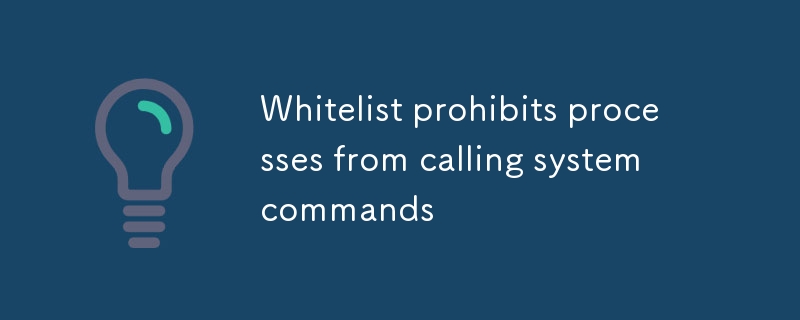本文讨论如何将调用系统命令的禁止进程列入白名单。将禁止的进程列入白名单有助于防止未经授权访问敏感系统命令,从而减少安全漏洞和数据泄露。本文提供了

白名单禁止调用系统命令的进程
如何将禁止调用系统命令的进程列入白名单?
要将禁止调用系统命令的进程列入白名单,可以使用auditd 工具创建允许特定进程执行某些命令的规则。具体操作方法如下:auditdtool to create a rule that allows specific processes to execute certain commands. Here's how you can do it:
/etc/audit/rules.d/whitelist.ruleswith the following content:-w /usr/bin/command -p x -c neverIn this rule,/usr/bin/commandis the command that you want to whitelist,-p xspecifies that the rule applies to processes with executable permission, and-c neverspecifies that the rule should never be enforced. You can add multiple rules to the file, each on a separate line.
auditdsystem by running the following command:sudo auditctl -R /etc/audit/rules.d/whitelist.rulesauditd:To ensure that the rules are applied immediately, restartauditdby running:sudo systemctl restart auditdWhat are the benefits of whitelisting forbidden processes?
Whitelisting forbidden processes can help prevent unauthorized access to sensitive system commands. By restricting the ability of certain processes to execute specific commands, you can reduce the risk of security breaches and data leaks.
What are some examples of forbidden processes?
Forbidden processes are typically processes that are not essential for the operation of the system and that could be used to compromise the system if they were allowed to execute certain commands. Examples of forbidden processes include:
How can I audit forbidden processes?
You can audit forbidden processes by using theauditctltool. To do this, run the following command:
sudo auditctl -w /usr/bin/command -p x -c idThis command will create an audit rule that logs all attempts by processes with executable permission to execute the/usr/bin/command
/etc/audit/rules.d/whitelist.rules的文件,其中包含以下内容:sudo cat /var/log/audit/audit.log | grep /usr/bin/command/usr/bin/command是您要加入白名单的命令,
-p x指定该规则适用于具有可执行权限的进程,并且
-c never指定永远不应该强制执行该规则。您可以向文件添加多个规则,每个规则在单独的行上。
auditd系统中以下命令:auditd: 要确保立即应用规则,请重新启动auditd通过运行:auditctl工具审核禁止的进程。为此,请运行以下命令:rrreee此命令将创建一个审核规则,记录具有可执行权限的进程执行
/usr/bin/command命令的所有尝试。您可以通过运行以下命令来查看审核日志:rrreee
以上是白名单禁止进程调用系统命令的详细内容。更多信息请关注PHP中文网其他相关文章!




